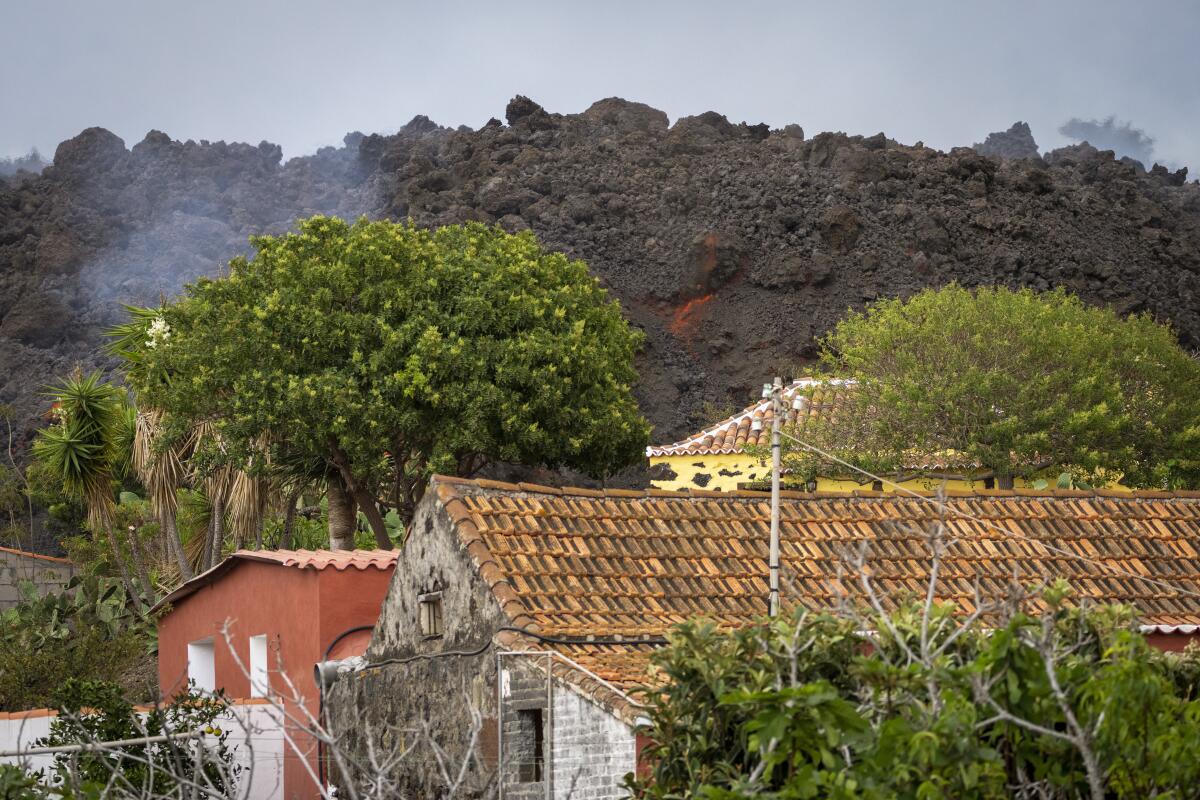‘My whole life in a van’: Islanders scramble as lava approaches from Spanish volcano eruption

TODOQUE, Canary Islands — A wall of lava up to 40 feet high bore down on a Spanish village Wednesday as islanders scrambled to save what they could before the molten rock swallowed up their homes after a volcanic eruption.
The lava, which was still spewing from Sunday’s eruption in the Canary Islands archipelago off northwest Africa, advanced slowly down hillsides of La Palma to the coast, where Todoque was the last village between it and the Atlantic Ocean. Residents hoping to save some belongings queued up so they could be escorted briefly into the village.
In the distance, the lava grew thicker and slowed down to 13 feet per hour after reaching a plain. Smoke poured out of its leading edge as it destroyed everything it touched.
Experts said the lava could either take several days to cover the remaining 1.25 miles to the sea or it could instead spread more widely on land, burying more residential areas and farmland.
Javier López said his house for the last three decades appeared to be in the lava’s path. He and his relatives had been staying at a friend’s house with the few documents, photos and basic belongings they had grabbed Monday as they were evacuated.
“I’ve put my whole life in a van,” López said, waiting for his turn to try to recover a vehicle and other valuables he had left behind.
“This is probably going to be the last time I see my home,” he said. “Or, in the best-case scenario, the house will remain isolated by the lava and inaccessible for who knows how long.”
Firefighting crews trying to save as many houses as possible worked nonstop to try to open a trench to divert the lava flow.
Melisa Rodríguez, another Todoque resident, was trying to stay positive and calm.
“It’s hard to think straight about what you want to save, but we are only allowed in for one hour and you don’t want to take longer because that would be taking time away from others,” she said.
The eruption was following an “expected pattern,” but there were still many uncertainties, said Vicente Soler, a volcanologist with Spain’s top scientific body, CSIC.
“It is difficult to say if the lava will reach the sea,” he told the BTC broadcaster. “If the source remains active and with a steady flow, it will be easy for it to arrive at the ocean. But if there are new lava diversions, that will slow down the flow’s head.”
But authorities and locals were taking no chances. As the lava headed toward the island’s more densely populated coast, 1,000 people were evacuated late Tuesday from Todoque, bringing the total number of evacuated on the island of La Palma to more than 6,800.
The few evacuees not staying with relatives or friends were being relocated Wednesday from a military barrack to a hotel, with the most vulnerable being moved to a nursing home. Island officials announced a plan to purchase unused housing to accommodate those who lost homes because of the eruption.
Speaking in New York after attending the U.N. General Assembly, Spanish Prime Minister Pedro Sánchez said he was confident that local, national and European authorities would contribute to the response to the eruption and the area’s reconstruction.
Authorities say more dangers lie ahead for residents, including more earthquakes, possible new lava flows, toxic gases, volcanic ash and acid rain. The lava, whose temperature exceeds more than 1,800 F, could cause explosions, trigger landslides and produce clouds of toxic gas when it hits the ocean.
As volcanic ash fell over a wide area, authorities advised people to keep children inside as much as possible because of possible breathing difficulties.
The volcanic eruption and its aftermath could last for up to 84 days, the Canary Island Volcanology Institute said, basing its calculation on previous eruptions in the archipelago that were also followed by heavy lava flows and lasting seismic activity.
Tuesday night saw a sharp increase in the number of smaller volcanic eruptions that hurl rocks and cinders high into the air, it said.
The lava has swallowed up about 320 buildings and now covers 380 acres, the institute said. It has ruined banana groves, vineyards and other crops. Prompt evacuations have helped avoid any casualties.
The volcano has also been spewing up to 10,500 tons of sulfur dioxide a day, which also affects the lungs, it said.
Life on the rest of La Palma, which is roughly 22 miles long and 12 miles wide at its broadest point, has been largely unaffected, with undeterred tourists landing for previously scheduled holidays. Air traffic remained normal.
The Canary Islands are a popular destination for European tourists due to their mild year-round climate.
Barry Hatton contributed from Lisbon.
More to Read
Sign up for Essential California
The most important California stories and recommendations in your inbox every morning.
You may occasionally receive promotional content from the Los Angeles Times.










